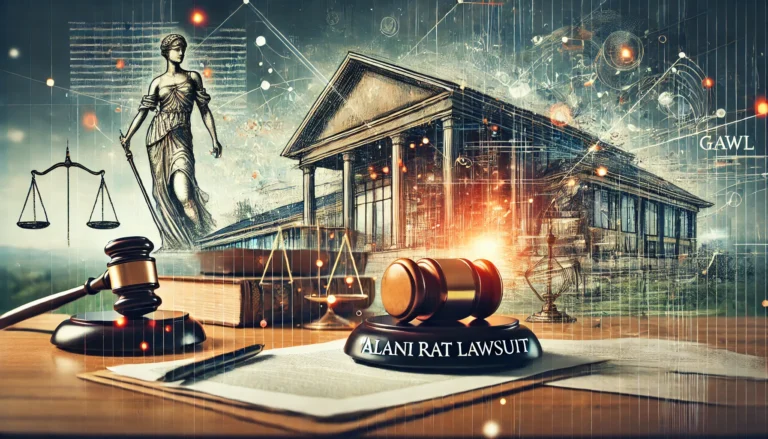The Alani Rat lawsuit refers to legal action taken against a company related to allegations of harm caused by a specific product, often involving claims of negligence or misrepresentation. This lawsuit has garnered attention due to its implications for consumer safety and corporate responsibility.
The case typically involves claims from consumers who believe they were adversely affected by the product, leading to health or safety issues. Understanding the context and details of this lawsuit is essential for those affected or interested in consumer rights.
This overview aims to provide clarity on the lawsuit’s background, the parties involved, and the potential legal outcomes. By exploring these aspects, individuals can gain insights into the broader implications of the case.
Ultimately, the Alani Rat lawsuit serves as a critical example of the intersection between consumer safety and corporate accountability.
Background: What Led to the Alani Rat Lawsuit?
The background of the Alani Rat lawsuit stems from concerns over the safety and efficacy of a product linked to alleged health risks. Reports from consumers highlighted unexpected side effects, prompting regulatory scrutiny and consumer complaints.
As more individuals shared their experiences, the volume of claims increased, leading to the filing of the lawsuit. The plaintiffs argue that the company failed to adequately warn consumers about potential risks associated with using the product.
Key factors that contributed to the lawsuit include:
- Inadequate Testing: Claims that the product was not tested sufficiently for safety.
- Misleading Advertising: Allegations that the marketing materials downplayed risks.
- Consumer Reports: Documented cases of adverse effects experienced by users.
These elements collectively fueled the legal action and highlighted the need for corporate accountability in product safety.
Key Parties Involved in the Alani Rat Lawsuit
The Alani Rat lawsuit involves several key parties, each playing a crucial role in the legal proceedings. Primarily, the plaintiffs are individuals who have experienced negative effects from the product in question, seeking justice and compensation for their suffering.
On the other side, the defendant is typically the company that manufactured or marketed the product. Their legal team will defend against the claims, often arguing that the product is safe when used as intended.
Additionally, regulatory bodies may also play a role, especially if there are concerns about product safety that warrant investigation. Their findings can influence the case’s direction and outcomes.
Understanding the roles of these parties is essential for comprehending the dynamics of the lawsuit and the potential implications for consumers and the industry.
Legal Claims Made in the Alani Rat Lawsuit
The legal claims made in the Alani Rat lawsuit center on allegations of negligence, product liability, and breach of warranty. Plaintiffs assert that the company failed to uphold its duty to ensure product safety and adequately inform consumers about potential risks.
Specific claims may include:
- Negligence: Arguing that the company did not take reasonable care in the product’s design or testing.
- Strict Liability: Asserting that the product was inherently unsafe, regardless of the company’s intent.
- Breach of Warranty: Claiming that the product did not meet the advertised standards or promises.
These legal claims form the foundation of the lawsuit, as plaintiffs seek to establish liability and secure compensation for damages suffered due to the alleged misconduct of the company.
The Impact of the Alani Rat Lawsuit on Consumers
The Alani Rat lawsuit has significant implications for consumers, particularly regarding awareness of product safety and corporate responsibility. As the case unfolds, it can highlight the importance of consumer rights and the need for transparency from companies.
Increased media coverage can lead to greater public scrutiny of similar products, prompting consumers to be more cautious and informed. This awareness may result in changes in purchasing behavior, with individuals seeking safer alternatives.
Additionally, the outcome of the lawsuit may set a precedent for future cases, influencing how companies approach product safety and consumer disclosures. A ruling in favor of the plaintiffs could encourage more individuals to speak out against unsafe products.
Overall, the lawsuit serves as a reminder of the ongoing need for vigilance in consumer protection and corporate accountability.
Timeline of Events Related to the Alani Rat Lawsuit
The timeline of events in the Alani Rat lawsuit illustrates the progression of the case from initial concerns to legal action. Key milestones typically include:
- Initial Reports: Early consumer complaints about adverse effects lead to growing awareness.
- Regulatory Review: Regulatory bodies begin investigating the claims and product safety.
- Filing of Lawsuit: Plaintiffs formally file the lawsuit, outlining their claims against the company.
- Pre-Trial Motions: Both parties engage in pre-trial motions, which may include requests for evidence and dismissals.
- Trial Proceedings: If the case goes to trial, it involves presenting evidence and arguments before a judge or jury.
This timeline helps contextualize the lawsuit and illustrates the complexity of legal proceedings surrounding product liability and consumer safety.
Understanding the Legal Process in the Alani Rat Lawsuit
The legal process in the Alani Rat lawsuit follows a structured path, beginning with the filing of the complaint by the plaintiffs. After filing, the court will schedule hearings and set timelines for both parties to exchange evidence.
Discovery is a crucial phase where both sides gather information to build their cases. This can include depositions, interrogatories, and requests for documents related to the product and its safety.
If the case does not settle during negotiations, it may proceed to trial. During the trial, both sides present their evidence and arguments, and a judge or jury ultimately makes a decision.
Post-trial, there may be opportunities for appeals, especially if either party believes there were legal errors during the trial. Understanding this legal process is vital for those involved in the lawsuit.
Potential Outcomes of the Alani Rat Lawsuit
The potential outcomes of the Alani Rat lawsuit can vary significantly based on the evidence presented and the legal arguments made. If the court rules in favor of the plaintiffs, several forms of compensation may be awarded, including monetary damages for medical expenses, lost wages, and pain and suffering.
A successful lawsuit could also lead to changes in company policies regarding product safety and consumer transparency. Companies may be required to issue recalls or reformulate products to prevent future issues, promoting safer practices within the industry.
Conversely, if the court rules in favor of the defendant, the plaintiffs may not receive any compensation. Additionally, the ruling could set a precedent that affects future cases involving similar claims, potentially making it more challenging for other victims to seek justice.
In summary, the outcome of the Alani Rat lawsuit has implications not only for the involved parties but also for consumer safety and corporate accountability in the broader marketplace.
How the Alani Rat Lawsuit Reflects Larger Issues
The Alani Rat lawsuit serves as a microcosm of larger issues within consumer rights and corporate responsibility. At its core, the case highlights the ongoing battle between consumer protection and corporate interests, particularly regarding product safety standards.
This lawsuit also emphasizes the importance of transparency in advertising. If companies fail to adequately inform consumers about potential risks associated with their products, they may face significant legal repercussions.
Moreover, the case sheds light on the challenges consumers face in seeking justice against larger corporations. Often, individuals may feel overwhelmed by the legal process, making it essential to have access to skilled legal representation.
Ultimately, the Alani Rat lawsuit not only addresses specific grievances but also underscores the need for systemic changes in how companies approach consumer safety and accountability.
Resources for Individuals Affected by the Alani Rat Lawsuit
Several resources are available for individuals affected by the Alani Rat lawsuit. Support groups and forums provide platforms for sharing experiences and advice, fostering a sense of community among those facing similar challenges.
Legal aid organizations can offer guidance on navigating the claims process and understanding individual rights. These resources are particularly valuable for those who may not have the financial means to hire private legal counsel.
In addition, educational resources, such as websites and publications focused on consumer rights, can help individuals understand the legal landscape surrounding product liability and safety.
Here’s a summary of potential resources:
| Resource Type | Description |
| Support Groups | Community forums for shared experiences |
| Legal Aid Organizations | Free or low-cost legal assistance |
| Educational Materials | Guides on consumer rights and legal processes |
Utilizing these resources can empower individuals to take informed steps toward seeking justice.
Final Thoughts on the Alani Rat Lawsuit and Its Implications
In conclusion, the Alani Rat lawsuit represents significant legal and consumer rights issues that resonate beyond the immediate case. As it unfolds, the lawsuit has the potential to influence public awareness regarding product safety and corporate accountability.
For individuals affected, the legal journey can be daunting but is crucial for achieving justice. Engaging with experienced legal professionals and utilizing available resources can provide the necessary support throughout the process.
Furthermore, the implications of this lawsuit extend to other consumers, prompting discussions about safety standards and regulatory practices within industries. Increased scrutiny may lead to enhanced consumer protections and a demand for transparency in marketing.
Ultimately, the Alani Rat lawsuit serves as a reminder of the importance of consumer advocacy and the need for robust legal frameworks to protect public health and safety.
Frequently Asked Questions (FAQs)
What is the Alani Rat lawsuit?
The Alani Rat lawsuit refers to legal action taken against a company regarding allegations of harm caused by a product associated with the Alani brand, often linked to consumer safety and health issues.
What are the main allegations in the Alani Rat lawsuit?
The main allegations typically involve claims of negligence, failure to adequately warn consumers about potential risks, and product liability due to adverse health effects experienced by users.
Who can file a claim in the Alani Rat lawsuit?
Individuals who have suffered health issues or adverse effects after using Alani products may be eligible to file a claim. This includes consumers who can demonstrate a direct link between their health problems and the product in question.
What types of compensation can victims seek in the Alani Rat lawsuit?
Victims may seek compensation for medical expenses, lost wages, pain and suffering, and emotional distress resulting from the use of the product. In some cases, punitive damages may also be pursued.
How can individuals participate in the Alani Rat lawsuit?
Individuals interested in participating can contact legal representatives specializing in class action lawsuits. They may need to provide evidence of their claims, such as medical records and documentation of product use.
What is the expected timeline for the Alani Rat lawsuit?
The timeline can vary widely depending on the complexity of the case, but legal proceedings can take months to years. Factors such as pre-trial motions, discovery phases, and potential settlements can influence the duration.
Where can I find more information about the Alani Rat lawsuit?
More information can typically be found on legal websites, news articles covering the case, and updates from law firms involved in the lawsuit. Additionally, consumer advocacy groups may provide resources related to the lawsuit and its implications.




